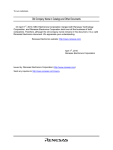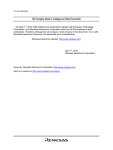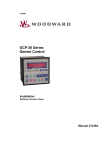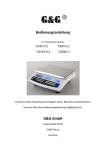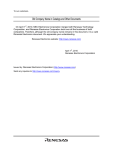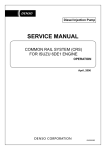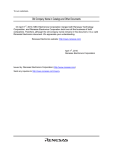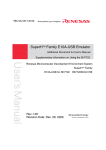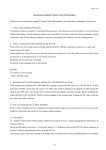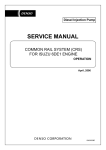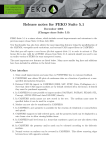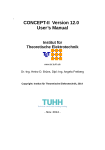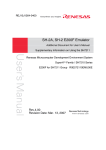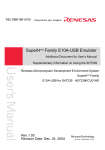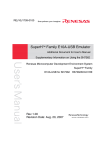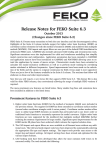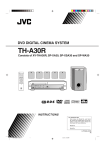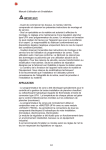Download SH-4A, SH4AL-DSP E200F Emulator Additional Document for
Transcript
To our customers, Old Company Name in Catalogs and Other Documents On April 1st, 2010, NEC Electronics Corporation merged with Renesas Technology Corporation, and Renesas Electronics Corporation took over all the business of both companies. Therefore, although the old company name remains in this document, it is a valid Renesas Electronics document. We appreciate your understanding. Renesas Electronics website: http://www.renesas.com April 1st, 2010 Renesas Electronics Corporation Issued by: Renesas Electronics Corporation (http://www.renesas.com) Send any inquiries to http://www.renesas.com/inquiry. Notice 1. 2. 3. 4. 5. 6. 7. All information included in this document is current as of the date this document is issued. Such information, however, is subject to change without any prior notice. Before purchasing or using any Renesas Electronics products listed herein, please confirm the latest product information with a Renesas Electronics sales office. Also, please pay regular and careful attention to additional and different information to be disclosed by Renesas Electronics such as that disclosed through our website. Renesas Electronics does not assume any liability for infringement of patents, copyrights, or other intellectual property rights of third parties by or arising from the use of Renesas Electronics products or technical information described in this document. No license, express, implied or otherwise, is granted hereby under any patents, copyrights or other intellectual property rights of Renesas Electronics or others. You should not alter, modify, copy, or otherwise misappropriate any Renesas Electronics product, whether in whole or in part. Descriptions of circuits, software and other related information in this document are provided only to illustrate the operation of semiconductor products and application examples. You are fully responsible for the incorporation of these circuits, software, and information in the design of your equipment. Renesas Electronics assumes no responsibility for any losses incurred by you or third parties arising from the use of these circuits, software, or information. When exporting the products or technology described in this document, you should comply with the applicable export control laws and regulations and follow the procedures required by such laws and regulations. You should not use Renesas Electronics products or the technology described in this document for any purpose relating to military applications or use by the military, including but not limited to the development of weapons of mass destruction. Renesas Electronics products and technology may not be used for or incorporated into any products or systems whose manufacture, use, or sale is prohibited under any applicable domestic or foreign laws or regulations. Renesas Electronics has used reasonable care in preparing the information included in this document, but Renesas Electronics does not warrant that such information is error free. Renesas Electronics assumes no liability whatsoever for any damages incurred by you resulting from errors in or omissions from the information included herein. Renesas Electronics products are classified according to the following three quality grades: “Standard”, “High Quality”, and “Specific”. The recommended applications for each Renesas Electronics product depends on the product’s quality grade, as indicated below. You must check the quality grade of each Renesas Electronics product before using it in a particular application. You may not use any Renesas Electronics product for any application categorized as “Specific” without the prior written consent of Renesas Electronics. Further, you may not use any Renesas Electronics product for any application for which it is not intended without the prior written consent of Renesas Electronics. Renesas Electronics shall not be in any way liable for any damages or losses incurred by you or third parties arising from the use of any Renesas Electronics product for an application categorized as “Specific” or for which the product is not intended where you have failed to obtain the prior written consent of Renesas Electronics. The quality grade of each Renesas Electronics product is “Standard” unless otherwise expressly specified in a Renesas Electronics data sheets or data books, etc. “Standard”: 8. 9. 10. 11. 12. Computers; office equipment; communications equipment; test and measurement equipment; audio and visual equipment; home electronic appliances; machine tools; personal electronic equipment; and industrial robots. “High Quality”: Transportation equipment (automobiles, trains, ships, etc.); traffic control systems; anti-disaster systems; anticrime systems; safety equipment; and medical equipment not specifically designed for life support. “Specific”: Aircraft; aerospace equipment; submersible repeaters; nuclear reactor control systems; medical equipment or systems for life support (e.g. artificial life support devices or systems), surgical implantations, or healthcare intervention (e.g. excision, etc.), and any other applications or purposes that pose a direct threat to human life. You should use the Renesas Electronics products described in this document within the range specified by Renesas Electronics, especially with respect to the maximum rating, operating supply voltage range, movement power voltage range, heat radiation characteristics, installation and other product characteristics. Renesas Electronics shall have no liability for malfunctions or damages arising out of the use of Renesas Electronics products beyond such specified ranges. Although Renesas Electronics endeavors to improve the quality and reliability of its products, semiconductor products have specific characteristics such as the occurrence of failure at a certain rate and malfunctions under certain use conditions. Further, Renesas Electronics products are not subject to radiation resistance design. Please be sure to implement safety measures to guard them against the possibility of physical injury, and injury or damage caused by fire in the event of the failure of a Renesas Electronics product, such as safety design for hardware and software including but not limited to redundancy, fire control and malfunction prevention, appropriate treatment for aging degradation or any other appropriate measures. Because the evaluation of microcomputer software alone is very difficult, please evaluate the safety of the final products or system manufactured by you. Please contact a Renesas Electronics sales office for details as to environmental matters such as the environmental compatibility of each Renesas Electronics product. Please use Renesas Electronics products in compliance with all applicable laws and regulations that regulate the inclusion or use of controlled substances, including without limitation, the EU RoHS Directive. Renesas Electronics assumes no liability for damages or losses occurring as a result of your noncompliance with applicable laws and regulations. This document may not be reproduced or duplicated, in any form, in whole or in part, without prior written consent of Renesas Electronics. Please contact a Renesas Electronics sales office if you have any questions regarding the information contained in this document or Renesas Electronics products, or if you have any other inquiries. (Note 1) “Renesas Electronics” as used in this document means Renesas Electronics Corporation and also includes its majorityowned subsidiaries. (Note 2) “Renesas Electronics product(s)” means any product developed or manufactured by or for Renesas Electronics. User’s Manual SH-4A, SH4AL-DSP E200F Emulator Additional Document for User’s Manual Supplementary Information on Using the SH7318 Renesas Microcomputer Development Environment System SuperH™ Family / SH7318 Series E200F for SH7318 R0E873180EMU00E Rev.3.00 2005.12 Keep safety first in your circuit designs! 1. Renesas Technology Corp. puts the maximum effort into making semiconductor products better and more reliable, but there is always the possibility that trouble may occur with them. Trouble with semiconductors may lead to personal injury, fire or property damage. Remember to give due consideration to safety when making your circuit designs, with appropriate measures such as (i) placement of substitutive, auxiliary circuits, (ii) use of nonflammable material or (iii) prevention against any malfunction or mishap. Notes regarding these materials 1. These materials are intended as a reference to assist our customers in the selection of the Renesas Technology Corp. product best suited to the customer's application; they do not convey any license under any intellectual property rights, or any other rights, belonging to Renesas Technology Corp. or a third party. 2. Renesas Technology Corp. assumes no responsibility for any damage, or infringement of any thirdparty's rights, originating in the use of any product data, diagrams, charts, programs, algorithms, or circuit application examples contained in these materials. 3. All information contained in these materials, including product data, diagrams, charts, programs and algorithms represents information on products at the time of publication of these materials, and are subject to change by Renesas Technology Corp. without notice due to product improvements or other reasons. It is therefore recommended that customers contact Renesas Technology Corp. or an authorized Renesas Technology Corp. product distributor for the latest product information before purchasing a product listed herein. The information described here may contain technical inaccuracies or typographical errors. Renesas Technology Corp. assumes no responsibility for any damage, liability, or other loss rising from these inaccuracies or errors. Please also pay attention to information published by Renesas Technology Corp. by various means, including the Renesas Technology Corp. Semiconductor home page (http://www.renesas.com). 4. When using any or all of the information contained in these materials, including product data, diagrams, charts, programs, and algorithms, please be sure to evaluate all information as a total system before making a final decision on the applicability of the information and products. Renesas Technology Corp. assumes no responsibility for any damage, liability or other loss resulting from the information contained herein. 5. Renesas Technology Corp. semiconductors are not designed or manufactured for use in a device or system that is used under circumstances in which human life is potentially at stake. Please contact Renesas Technology Corp. or an authorized Renesas Technology Corp. product distributor when considering the use of a product contained herein for any specific purposes, such as apparatus or systems for transportation, vehicular, medical, aerospace, nuclear, or undersea repeater use. 6. The prior written approval of Renesas Technology Corp. is necessary to reprint or reproduce in whole or in part these materials. 7. If these products or technologies are subject to the Japanese export control restrictions, they must be exported under a license from the Japanese government and cannot be imported into a country other than the approved destination. Any diversion or reexport contrary to the export control laws and regulations of Japan and/or the country of destination is prohibited. 8. Please contact Renesas Technology Corp. for further details on these materials or the products contained therein. Contents Section 1 Connecting the Emulator with the User System ................................1 1.1 1.2 1.3 1.4 1.5 Components of the Emulator ............................................................................................ 1 Connecting the Emulator with the User System ............................................................... 3 Installing the H-UDI Port Connector on the User System ................................................ 4 Pin Assignments of the H-UDI Port Connector ................................................................ 4 Recommended Circuit between the H-UDI Port Connector and the MPU....................... 6 1.5.1 Recommended Circuit (36-Pin Type) .................................................................. 6 Section 2 Software Specifications when Using the SH7318 .............................9 2.1 2.2 Differences between the SH7318 and the Emulator ......................................................... 9 Specific Functions for the Emulator when Using the SH7318.......................................... 14 2.2.1 Notes on Using the Trace Functions .................................................................... 14 2.2.2 Notes on Using the JTAG (H-UDI) Clock (TCK) and AUD Clock (AUDCK)... 16 2.2.3 Notes on Setting the [Breakpoint] Dialog Box .................................................... 16 2.2.4 Notes on Setting the [Event Condition] Dialog Box and the BREAKCONDITION_ SET Command ........................................................ 17 2.2.5 Note on Setting the UBC_MODE Command ...................................................... 18 2.2.6 Note on Setting the PPC_MODE Command ....................................................... 18 Section 3 I/O Analyzer Function .......................................................................19 3.1 3.2 3.3 3.4 3.5 Overview of the MFI Trace Functions.............................................................................. 20 Using the MFI Trace Functions ........................................................................................ 22 Connecting the Emulator with the User System ............................................................... 27 Installing the MFI Trace Connector .................................................................................. 27 3.4.1 MFI Trace Connector Installed on the User System ............................................ 27 3.4.2 Pin Assignments of the MFI Trace Connector..................................................... 27 3.4.3 Layout of the MFI Trace Connector .................................................................... 30 3.4.4 Recommended Circuit between the MFI Trace Connector and the MPU............ 32 Restrictions on the MFI Trace and MFI Extended Monitor for I/O Analyzer Function ... 34 Section 4 Preparing to Connect the Trace Unit .................................................35 4.1 4.2 Connecting the E200F Trace Unit with the User System.................................................. 35 Installing the Trace Unit Connector .................................................................................. 35 4.2.1 Trace Unit Connector Installed on the User System ............................................ 35 4.2.2 Pin Assignments of the User System Connector.................................................. 36 4.2.3 Recommended Foot Pattern ................................................................................. 36 i 4.2.4 4.2.5 4.2.6 4.2.7 4.2.8 ii Restrictions on Component Installation ............................................................... 37 Pin Assignments of the Trace Unit Connector..................................................... 37 Layout of the Trace Unit Connector .................................................................... 50 Restrictions on Using the Trace Unit................................................................... 51 Description of Emulation Memory Control Signal.............................................. 53 Section 1 Connecting the Emulator with the User System 1.1 Components of the Emulator The E200F emulator supports the SH7318. Table 1.1 lists the components of the emulator. Table 1.1 Components of the Emulator Classification Component Hardware Appearance Quantity Remarks Emulator main unit 1 R0E0200F0EMU00: Depth: 185.0 mm, Width: 130.0 mm, Height: 45.0 mm, Mass: 321.0 g AC adapter (serial numbers: 0081 or before) 1 Input: 100 to 240 V Output: 12 V 4.0 A Depth: 120.0 mm, Width: 72.0 mm, Height: 27.0 mm, Mass: 400.0 g AC adapter (serial numbers: 0082 or after) 1 Input: 100 to 240 V Output: 12 V 3.0 A Depth: 99.0 mm, Width: 62.0 mm, Height: 26.0 mm, Mass: 270.0 g AC cable 1 Length: 200 mm USB cable 1 Length: 1500 mm, Mass: 50.6 g 1 Table 1.1 Components of the Emulator (cont) Classification Component Hardware (cont) Software Appearance Quantity Remarks External probe (serial numbers: 0081 or before) 1 Length: 500 mm, Pins 1 to 4: probe input pins, T: trigger output pin, G: GND pin External probe (serial numbers: 0082 or after) 1 Length: 500 mm, Pins 1 to 4: probe input pins, T: trigger output pin, G: GND pin E200F emulator setup program, 1 R0E0200F0EMU00S, SH-4A, SH4AL-DSP E200F Emulator User’s Manual, R0E0200F0EMU00J, R0E0200F0EMU00E, Supplementary Information on Using the SH7318* R0E873180EMU00J, R0E873180EMU00E (provided on a CD-R) Note: Additional document for the MPUs supported by the emulator is included. Check the target MPU and refer to its additional document. 2 1.2 Connecting the Emulator with the User System To connect the E200F emulator (hereinafter referred to as the emulator), the H-UDI port connector must be installed on the user system to connect the user system interface cable. When designing the user system, refer to the recommended circuit between the H-UDI port connector and the MPU. It is impossible to connect the emulator to the 14-pin type connector that is recommended for the E10A-USB emulator. The 36-pin type connector is the same as that of the E10A-USB emulator. When designing the user system, read the E200F emulator user's manual and hardware manual for the related device. The H-UDI port connector has the 36-pin and 14-pin types as described below. Use them according to the purpose of the usage. 1. 36-pin type (with AUD function) The AUD trace function is supported. A large amount of trace information can be acquired in realtime. The window trace function is also supported for acquiring memory access in the specified range (memory access address or memory access data) by tracing. 2. 14-pin type (without AUD function) The AUD trace function cannot be used because only the H-UDI function is supported. This connector type is not available for the E200F emulator; the E10A-USB emulator is available. 3 1.3 Installing the H-UDI Port Connector on the User System Table 1.2 shows the recommended H-UDI port connectors for the emulator. Table 1.2 Recommended H-UDI Port Connectors Connector Type Number Manufacturer Specifications 36-pin connector DX10M-36S Hirose Electric Co., Ltd. Screw type DX10M-36SE, DX10G1M-36SE Lock-pin type Note: When designing the 36-pin connector layout on the user board, do not place any other signals under the H-UDI connector to reduce cross-talk noises, etc. 1.4 Pin Assignments of the H-UDI Port Connector Figure 1.1 shows the pin assignments of the 36-pin H-UDI port connector. Note: Note that the pin number assignments of the H-UDI port connector shown on the following page differs from those of the connector manufacturer. 4 Pin No. Signal Input/ Output *1 1 AUDCK Output E10 2 GND 3 AUDATA0 Output C7 SH7318 Pin No. Note Pin No. Signal Input/ Output*1 19 TMS Input F11 20 GND 21 /TRST *2 Input C10 22 (GND) *4 23 TDI Input C11 24 GND 25 TDO Output D12 26 GND 27 /ASEBRK *2 /BRKACK Input/ output F10 28 GND 29 UVCC 4 GND 5 AUDATA1 6 GND 7 AUDATA2 8 GND 9 AUDATA3 10 GND 11 /AUDSYNC*2 12 GND 30 GND 13 NC 31 /RESETP 14 GND 32 GND 15 NC 33 GND *3 16 GND 34 GND 17 TCK 18 GND Output Output F8 E9 Output D11 Output H6 Input C9 35 NC 36 GND SH7318 Pin No. Note Output *2 Output F7 User reset Output Notes: 1. Input to or output from the user system. 2. The slash (/) means that the signal is active-low. 3. The emulator monitors the GND signal of the user system and detects whether or not the user system is connected. 4. When the user system interface cable is connected to this pin and the MPMD pin is set to 0, do not connect to GND but to the MPMD pin directly. H-UDI port connector (top view) Edge of the board (connected to the connector) φ 0.7+0.1 0 36 1 3 9.0 1.905 1.1 4.5 2 φ 2.8+0.2 0 4 (Pin 1 mark) 35 1.27 4.09 M2.6 x 0.45 H-UDI port connector (front view) 4.8 H-UDI port connector (top view) 3.9 37.61 43.51 : Pattern inhibited area 0.3 9.0 21.59 Unit: mm Figure 1.1 Pin Assignments of the H-UDI Port Connector (36 Pins) 5 1.5 Recommended Circuit between the H-UDI Port Connector and the MPU 1.5.1 Recommended Circuit (36-Pin Type) Figure 1.2 shows a recommended circuit for connection between the H-UDI and AUD port connectors (36 pins) and the MPU when the emulator is in use. Notes: 1. Do not connect anything to the N.C. pins of the H-UDI port connector. 6 2. The MPMD pin must be 0 when the emulator is connected and 1 when the emulator is not connected, respectively. (1) When the emulator is used: MPMD = 0 (2) When the emulator is not used: MPMD = 1 Figure 1.2 shows an examples of circuits that allow the MPMD pin to be GND (0) whenever the emulator is connected by using the user system interface cable. 3. When a network resistance is used for pull-up, it may be affected by a noise. Separate TCK from other resistances. 4. The /TRST pin must be at the low level for a certain period when the power is supplied whether the H-UDI is used or not. Reduce the power supplied to the /TRST pin by pulling the pin down by a resistance of 1 kilo-ohm and setting PUL10 = 0 in the PULCR register after a reset. 5. The pattern between the H-UDI port connector and the MPU must be as short as possible. Do not connect the signal lines to other components on the board. 6. Since the H-UDI and the AUD of the MPU operate with the Vcc, supply only the Vcc to the UVCC pin. 7. The resistance values shown in figure 1.2 are reference. 8. For the pin processing in cases where the emulator is not used, refer to the hardware manual of the related MPU. 9. For the AUDCK pin, guard the pattern between the H-UDI port connector and the MPU at GND level. Vcc = 2.85-V I/O power supply All pulled-up at 4.7 kΩ or more Vcc Vcc Vcc Vcc Vcc Vcc H-UDI port connector (36-pin type) 2 4 6 8 10 12 14 16 18 20 22 24 26 28 30 32 34 36 GND AUDCK GND AUDATA0 GND AUDATA1 GND GND GND AUDATA2 AUDATA3 AUDSYNC 1 AUDSYNC 15 TCK 17 TMS 19 TCK TMS 21 TRST TDI 23 25 GND TDO ASEBRK /BRKACK GND UVCC GND RESETP GND GND GND N.C. GND AUDATA3 11 N.C. GND AUDATA2 9 GND TRST AUDATA1 7 13 (GND) AUDATA0 5 N.C. GND AUDCK 3 GND GND SH7318 TDI TDO 27 ASEBRK /BRKACK 29 31 33 RESETP 1 kΩ 35 Reset signal MPMD User system Figure 1.2 Recommended Circuit for Connection between the H-UDI Port Connector and MPU when the Emulator is in Use (36-Pin Type) 7 8 Section 2 Software Specifications when Using the SH7318 2.1 Differences between the SH7318 and the Emulator 1. When the emulator system is initiated, it initializes the general registers and part of the control registers as shown in table 2.1. The initial values of the actual SH7318 registers are undefined. When the emulator is initiated from the workspace, a value to be entered is saved in a session. Table 2.1 Register Initial Values at Emulator Link Up Register Emulator at Link Up R0 to R14 H'00000000 R15 (SP) H'A0000000 R0_BANK to R7_BANK H'00000000 PC H'A0000000 SR H'700000F0 GBR H'00000000 VBR H'00000000 MACH H'00000000 MACL H'00000000 PR H'00000000 SPC H'00000000 SSR H'000000F0 RS H'00000000 RE H'00000000 MOD H'00000000 A0G, A1G H'00000000 A0, A1 H'00000000 X0, X1 H'00000000 Y0, Y1 H'00000000 M0, M1 H'00000000 DSR H'00000000 2. The emulator uses the H-UDI; do not access the H-UDI. 9 3. Low-Power States (Sleep, Software Standby, Module Standby, U Standby, and R Standby) For low-power consumption, the SH7318 has sleep, software standby, module standby, U standby, and R standby states. The sleep, software standby, and module standby states are switched using the SLEEP instruction. When the emulator is used, the sleep state can be cleared with either the normal clearing function or with the [STOP] button, and a break will occur. Note: The memory must not be accessed or modified in sleep state. 4. Reset Signals The SH7318 reset signals are only valid during emulation started with clicking the GO or STEP-type button. If these signals are enabled on the user system in command input wait state, they are not sent to the SH7318. Note: Do not break the user program when the /RESETP, /BREQ, or /WAIT signal is being low. A TIMEOUT error will occur. If the /BREQ or /WAIT signal is fixed to low during break, a TIMEOUT error will occur at memory access. 5. Direct Memory Access Controller (DMAC) The DMAC operates even when the emulator is used. When a data transfer request is generated, the DMAC executes DMA transfer. 6. Memory Access during User Program Execution When a memory is accessed from the memory window, etc. during user program execution, the user program is resumed after it has stopped in the emulator to access the memory. Therefore, realtime emulation cannot be performed. The stopping time of the user program is as follows: Environment: ® Host computer: 800 MHz (Pentium III) JTAG clock: 30 MHz (TCK clock) When a one-byte memory is read from the command-line window, the stopping time will be about 45 ms. 7. Memory Access during User Program Break The emulator can download the program for the flash memory area (for details, refer to section 6.22, Download Function to the Flash Memory Area, in the SH-4A, SH4AL-DSP E200F Emulator User’s Manual). Other memory write operations are enabled for the RAM area. Therefore, an operation such as memory write or BREAKPOINT should be set only for the RAM area. 10 8. Cache Operation during User Program Break When cache is enabled, the emulator accesses the memory by the following methods: • At memory write: Writes through the cache, then issues a single write to outside. The LRU is not updated. • At memory read: Reads memory from the cache. The LRU is not updated. Therefore, when memory read or write is performed during user program break, the cache state does not change. • At breakpoint set: Disables the instruction cache. 9. Port G The AUD pin is multiplexed as shown in table 2.2. Table 2.2 Multiplexed Functions Port Function 1 Function 2 G PTG4 input/output (port)* /AUDSYNC (AUD) G PTG3 input/output (port)* AUDATA3 (AUD) G PTG2 input/output (port)* AUDATA2 (AUD) G PTG1 input/output (port)* AUDATA1 (AUD) G PTG0 input/output (port)* AUDATA0 (AUD) Note: Function 1 can be used when the AUD pins of the device are not connected to the emulator. When the AUD trace function is enabled, the emulator changes settings so that function 2 is forcibly used. 10. UBC When [User] is specified in the [UBC mode] list box in the [Configuration] dialog box, the UBC can be used in the user program. Do not use the UBC in the user program as it is used by the emulator when [EML] is specified in the [UBC mode] list box in the [Configuration] dialog box. 11. MFI When the MFI boot mode is used, be sure to activate the emulator by setting the RESETOUT signal as a trigger for the MFI transfer from the base-band side. In the active-through mode, the emulator does not operate during break. 12. Using RWDT At power-on reset, the operation of RWDT is enabled. When RWDT is not used, be sure to disable the operation of RWDT at the top of the user-reset program. The RWTCSR.TME bit is masked as 0 during break. Therefore, 0 is always displayed in the [IO] and [Memory] windows. 11 13. Memory Access during Break In the enabled MMU, when a memory is accessed and a TLB error occurs during break, it can be selected whether the TLB exception is controlled or the program jumps to the user exception handler in [TLB Mode] in the [Configuration] dialog box. When [TLB miss exception is enable] is selected, a “Communication Timeout error” will occur if the TLB exception handler does not operate correctly. When [TLB miss exception is disable] is selected, the program does not jump to the TLB exception handler even if a TLB exception occurs. Therefore, if the TLB exception handler does not operate correctly, a “Communication Timeout error” will not occur but the memory contents may not be correctly displayed. 14. Loading Sessions Information in [JTAG clock] of the [Configuration] dialog box cannot be recovered by loading sessions. Thus the TCK value will be 1.25 MHz. 15. [IO] window • Display and modification Do not change values of the User Break Controller because it is used by the emulator. For each RWDT register, there are two registers to be separately used for write and read operations. Table 2.3 RWDT Register Register Name Usage Register RWTCSR(W) Write RWDT control/status register RWTCNT(W) Write RWDT counter RWTCSR(R) Read RWDT control/status register RWTCNT(R) Read RWDT counter The RWDT operates only when the user program is executed. Do not change the value of the frequency change register in the [IO] window or [Memory] window. The internal I/O registers can be accessed from the [IO] window. However, note the following when accessing the SDMR register of the bus-state controller. Before accessing the SDMR register, specify addresses to be accessed in the I/O-register definition file (SH7318.IO) and then activate the High-performance Embedded Workshop. After the I/Oregister definition file is created, the MPU’s specifications may be changed. If each I/O register in the I/O-register definition file differs from addresses described in the hardware manual, change the I/O-register definition file according to the description in the hardware manual. The I/O-register definition file can be customized depending on its format. Note that, however, the E200F emulator does not support the bit-field function. 12 • Verify In the [IO] window, the verify function of the input value is disabled. 16. Illegal Instructions If illegal instructions are executed by STEP-type commands, the emulator cannot go to the next program counter. 17. [Reset CPU] and [Reset Go] in the [Debug] Menu When a reset is issued from [Reset CPU] or [Reset Go] in the [Debug] menu, the clock pulse generator or system controller is not initialized. 13 2.2 Specific Functions for the Emulator when Using the SH7318 In the SH7318, a reset must be input when the emulator is activated. 2.2.1 Notes on Using the Trace Functions The emulator supports the trace functions listed in table 2.4. Table 2.4 Trace Functions Function Internal Trace AUD Trace Memory Output Trace Branch trace Supported (eight branches) Supported Supported Range memory access trace Supported (eight events) Supported Supported Software trace Supported (eight events) Supported Supported Internal Trace Function: This function is activated by selecting the [Internal trace] radio button in the [Trace type] group box of the [Trace mode] page. Set the trace condition to be used. Notes: 1. If an interrupt is generated at the program execution start or end, including a step operation, the emulator address may be acquired. In such a case, the following message will be displayed. Ignore this address because it is not a user program address. *** EML *** 2. If a completion-type exception occurs during exception branch acquisition, the next address to the address in which an exception occurs is acquired. 3. Trace information cannot be acquired for the following branch instructions: • The BF and BT instructions whose displacement value is 0 • Branch to H'A0000000 by reset AUD Trace Function: This function is operational when the AUD pin of the device is connected to the emulator. It is activated by selecting the [AUD trace] radio button in the [Trace type] group box of the [Trace mode] page. Notes: 1. When the trace display is performed during user program execution, the mnemonics, operands, or source is not displayed. 2. The AUD branch trace function outputs the differences between newly output branch source addresses and previously output branch source addresses. The window trace function outputs the differences between newly output addresses and previously output addresses. If the previously output address is the same as the upper 16 bits, the lower 14 16 bits are output. If it matches the upper 24 bits, the lower 8 bits are output. If it matches the upper 28 bits, the lower 4 bits are output. The emulator regenerates the 32-bit address from these differences and displays it in the [Trace] window. If the emulator cannot display the 32-bit address, it displays the difference from the previously displayed 32-bit address. 3. If the 32-bit address cannot be displayed, the source line is not displayed. 4. In the emulator, when multiple loops are performed to reduce the number of AUD trace displays, only the IP counts up. 5. In the emulator, the maximum number of trace displays is 524288 lines. However, the maximum number of trace displays differs according to the AUD trace information to be output. Therefore, the above pointers cannot be always acquired. 6. The AUD trace acquisition is not available when [User] is selected in the [UBC mode] list box of the [Configuration] dialog box. In this case, close the [Trace] window. 7. Do not use the AUD full-trace mode for the VIO function. 8. If a completion-type exception occurs during exception branch acquisition, the next address to the address in which an exception occurs is acquired. Memory Output Trace Functions: This function is activated by selecting the [Use Memory trace] radio button in the [Trace type] group box of the [Trace mode] page. In this function, write the trace data in the specified user memory range. Specify the start address to output a trace for the [Start] edit box in the [User memory area] group box, and the end address for the [End Address] edit box. Notes: 1. Use only the following addresses in the memory range for which trace is output: <External memory area> CS0, CS2, CS4, CS5A, CS5B, CS6A, and CS6B <Internal memory area> URAM: H’055E0000 to H’0561FFFF XRAM: H’05007000 to H’05008FFF YRAM: H’05017000 to H’05018FFF Note that this address is on the system bus and not supported for the MMU or cache. 2. In the memory range for output, do not specify the ranges that the user program has been downloaded or the user program accesses. 3. The range for trace output must be 1 MB or less. 15 2.2.2 Notes on Using the JTAG (H-UDI) Clock (TCK) and AUD Clock (AUDCK) 1. Set the JTAG clock (TCK) frequency to lower than the frequency of the SH7318 peripheral module clock (CKP). 2. Set the AUD clock (AUDCK) frequency to 108 MHz or lower. If the frequency is higher than 108 MHz, the emulator will not operate normally. 3. The set value of the JTAG clock (TCK) is initialized by executing [Reset CPU] or [Reset Go]. 2.2.3 Notes on Setting the [Breakpoint] Dialog Box 1. When an odd address is set, the next lowest even address is used. 2. A BREAKPOINT is accomplished by replacing instructions of the specified address. Accordingly, it can be set only to the internal RAM area. However, a BREAKPOINT cannot be set to the following addresses: • ROM areas in CS0 to CS6 • Areas other than CS0 to CS6 • Areas other than the internal RAM • A slot instruction of a delayed branch instruction • An area that can be only read by MMU 3. During step operation, BREAKPOINTs are disabled. 4. When execution resumes from the address where a BREAKPOINT is specified, single-step operation is performed at the address and execution is continued from the next PC value. Therefore, realtime operation cannot be performed. 5. When a BREAKPOINT is set to the slot instruction of a delayed branch instruction, the PC value becomes an illegal value. Accordingly, do not set a BREAKPOINT to the slot instruction of a delayed branch instruction. 6. Note on DSP repeat loop: A BREAKPOINT is equal to a branch instruction. In some DSP repeat loops, branch instructions cannot be set. For these cases, do not set BREAKPOINTs. Refer to the hardware manual for details. 7. When the [Normal] option is selected in the [Memory area] group box in the [General] page of the [Configuration] dialog box, a BREAKPOINT is set to a physical address or a virtual address according to the SH7318 MMU status during command input when the VPMAP_SET command setting is disabled. The ASID value of the SH7318 PTEH register during command input is used. When VPMAP_SET command setting is enabled, a BREAKPOINT is set to a physical address into which address translation is made according to the VP_MAP table. However, for addresses out of the range of the VP_MAP table, the address to which a BREAKPOINT is set depends on the SH7318 MMU status during command input. Even 16 when the VP_MAP table is modified after BREAKPOINT setting, the address translated when the BREAKPOINT is set valid. 8. When the [Physical] option is selected in the [Memory area] group box in the [General] page of the [Configuration] dialog box, a BREAKPOINT is set to a physical address. A BREAKPOINT is set after disabling the SH7318 MMU upon program execution. After setting, the MMU is returned to the original state. When a break occurs at the corresponding virtual address, the cause of termination displayed in the status bar and the [Output] window is ILLEGAL INSTRUCTION, not BREAKPOINT. 9. When the [Virtual] option is selected in the [Memory area] group box in the [General] page of the [Configuration] dialog box, a BREAKPOINT is set to a virtual address. A BREAKPOINT is set after enabling the SH7318 MMU upon program execution. After setting, the MMU is returned to the original state. When an ASID value is specified, the BREAKPOINT is set to the virtual address corresponding to the ASID value. The emulator sets the BREAKPOINT after rewriting the ASID value to the specified value, and returns the ASID value to its original value after setting. When no ASID value is specified, the BREAKPOINT is set to a virtual address corresponding to the ASID value at command input. 10. An address (physical address) to which a BREAKPOINT is set is determined when the BREAKPOINT is set. Accordingly, even if the VP_MAP table is modified after BREAKPOINT setting, the BREAKPOINT address remains unchanged. When a BREAKPOINT is satisfied with the modified address in the VP_MAP table, the cause of termination displayed in the status bar and the [Output] window is ILLEGAL INSTRUCTION, not BREAKPOINT. 11. If an address of a BREAKPOINT cannot be correctly set in the ROM or flash memory area, a mark z will be displayed in the [BP] area of the address on the [Source] or [Disassembly] window by refreshing the [Memory] window, etc. after Go execution. However, no break will occur at this address. When the program halts with the event condition, the mark z disappears. 2.2.4 Notes on Setting the [Event Condition] Dialog Box and the BREAKCONDITION_ SET Command 1. When [Go to cursor], [Step In], [Step Over], or [Step Out] is selected, the settings of Event Condition 3 are disabled. 2. When an Event Condition is satisfied, emulation may stop after two or more instructions have been executed. 3. If a PC break address condition is set to the slot instruction after a delayed branch instruction, user program execution cannot be terminated before the slot instruction execution; execution stops before the branch destination instruction. 17 2.2.5 Note on Setting the UBC_MODE Command In the [Configuration] dialog box, if [User] is set while the [UBC mode] list box has been set, Ch10 (IA_OA_R) and Ch11 (OA_OA_CT_R) of Event Condition cannot be used. 2.2.6 Note on Setting the PPC_MODE Command In the [Configuration] dialog box, if [User] is set while the [PPC mode] list box has been set, Ch1 and Ch2 of the performance analysis function and options 1 and 2 of the profile function cannot be used. 18 Section 3 I/O Analyzer Function The emulator supports the function that is used to trace or analyze the state of the specific I/O. For SH7318, the emulation function specific to Multi Function Interface (MFI) is supported. 19 3.1 Overview of the MFI Trace Functions (1) Displaying the states of pins and settings of MFI The latest state is always displayed during a break or running. The following pins and states are displayed. Table 3.1 MFI Pin States No. Pin and State Display Contents 1 MFI Mode Displays mode that the MPU has been started up. General: Normal boot mode. During MFI boot: Downloading to MFRAM is not completed. Branch to MFRAM: Preparation of boot from MFRAM is completed. Extend through: Extended through mode and normal boot mode. 2 MFI Bit Mode Displays the current MFI bus width. 3 MFI MFRAM Endian Displays the endian when accessing the MFRAM from the onchip CPU. 4 MFI Bus Order Displays the byte order in MFIDATA31 to MFIDATA0 data; the byte order corresponds to the MFIADR1 and MFIADR0 bits. 5 MFI INTERRUPT Displays that an interrupt by the MFIINT pin has occurred. 6 MFI Register (MFIGSR) Displays the value of the MFIGSR register that has been read from or written to via MFI. 7 MFI Register Access (MFIxxxx) Displays whether or not the MFIxxxx register has been accessed via MFI. The following register names are displayed: MFIDEVCR, MFISW4, MFIBCR, MFIDATA, MFIADR, MFIEICR, MFIICR, MFIMCR, MFISCR, and MFIGSR 8 Signal xxxxxxx (MFI Connector) Displays the state of the xxxxxx pin that is connected to the MFI connector. The following pin names are displayed: STATUS0, PDSTATUS, and RESETP 9 Signal xxxxxxx Displays the state of the xxxxxx pin for MFI that is connected to the MFI connector. The following pin names are displayed: THEXT, MFIMD, MFIE//WR, MFIRW//RD, /THCS, /MFICS, /MFIINT, THMSK, THMDCH, THA3, MFIRS/THA2, and THA1 20 (2) Tracing the data transfer via MFI The following pins and states are acquired by a trace. Table 3.2 Contents Traced via MFI No. Pin and State Header of the [Trace] Window Description 1 Transfer data Data Displays the value of transfer data. 2 Read or write R/W Displays the type of read of write. 3 Access Instruction Displays the access type. Index register access: Access to the MFIIDX register. MFI register access: Access to the internal register of MFI. Through register access: Access to the through register. SH bus register access: Access to the MPU directly connected to the SH bus. 4 Pin states MFICS-THCS-THA3THA2-THA1-THMDCHMFIINT Displays the states of MFICS, THCS, THA3, THA2, THA1, THMDCH, and MFIINT. 5 Time stamp Timestamp Displays the time stamp. Timestamp-Difference Displays the difference between the previous trace data. Note: If [NOP] or [Invalid access] is displayed on the [Instruction] column, connection failure may occur. 21 3.2 Using the MFI Trace Functions (1) Using the function to display the states of pins and settings of MFI The states are displayed in the [Extended Monitor] window that is opened by selecting [Extended Monitor] from [CPU] of the [View] menu. Figure 3.1 [Extended Monitor] Window When [Properties…] is selected from the popup menu that is opened by right-clicking on the [Extended Monitor] window, the [Extended Monitor Configuration] dialog box is displayed. In this dialog box, items to be displayed can be selected. 22 (2) Using the function to trace the data transfer via MFI The [Trace Window Type] dialog box is displayed by selecting [Trace] from [Code] of the [View] menu. Select [BUS/MFI Trace] to open the [BUS/MFI Trace] window. Figure 3.2 [BUS/MFI Trace] Window The MFI trace cannot be used with the bus trace. It is required that [MFI trace] has been selected in the [BUS/MFI acquisition] dialog box. The following describes how to change and check the trace settings. Select [Set] from the popup menu that is displayed by right-clicking the [Trace] window. The [BUS/MFI acquisition] dialog box is displayed. 23 Figure 3.3 [BUS/MFI acquisition] Dialog Box (a) To view the MFI setting information when the MFI or MPU is booted: Accessing via MFI will have been completed when the emulator has been activated. The emulator polls the /RESETOUT pin that shows the completion of reset within the MPU, and acquires the MFI access by a trace without any conditions when the state of the /RESETOUT pin becomes high. After the emulator is activated, select [MFI trace] on the [BUS/MFI acquisition] dialog box and display the [BUS/MFI Trace] window. It is possible to select [Halt] from the popup menu of the [BUS/MFI Trace] window. When [Halt] is selected, the acquired trace information is displayed on the [BUS/MFI Trace] window. 24 (b) To view the MFI access during a break: Select [MFI trace] on the [BUS/MFI acquisition] dialog box and display the [BUS/MFI Trace] window. It is possible to select [Halt] or [Restart] from the popup menu of the [BUS/MFI Trace] window. When [Halt] is available, trace information has been acquired. When [Halt] is selected here, the acquired trace information is displayed. When [Restart] is available, trace acquisition has not been started. When [Restart] is selected here, acquiring the trace information is started. (c) To view the MFI access during execution of the user program: The start of execution of the user program and acquisition of the trace information does not occur at the same time. To start acquiring the trace information, select [Restart]. It is possible to select [Halt] from the popup menu of the [BUS/MFI Trace] window. When [Halt] is selected, the acquired trace information is displayed and [Restart] becomes available. When [Restart] is selected, acquiring the trace information is started at that time. (d) Filter or find function for the data acquired by a trace: When [Filter] or [Find] is selected from the popup menu of the [BUS/MFI Trace] window, the dialog box for that purpose is displayed. The data displayed on the [BUS/MFI Trace] window can be filtered or found with a data value. 25 (e) To specify the data to be acquired by a trace: It is possible to set acquiring the required MFI trace data on the [Other event] sheet of the [Event] window. • MFI Ch1 and Ch2 The MFI trace can be started or halted by using the condition that has been set for these channels. It is also possible that only the condition is acquired by a trace or output as a trigger when the condition is satisfied. Figure 3.4 shows the dialog box to set the condition. Figure 3.4 [MFI Ch1] Dialog Box Conditions can be set on the [Condition] sheet. The operation when the condition is satisfied can be set on the [Action] sheet. 26 3.3 Connecting the Emulator with the User System To use the MFI trace function, the emulator must be connected to the user system with the MFI trace cable. Install the MFI trace connector on the user system to connect the MFI trace cable, referring to section 3.4, Installing the MFI Trace Connector, in this manual. When designing the user system, read the E200F emulator user's manual and hardware manual for the related MPU. 3.4 Installing the MFI Trace Connector 3.4.1 MFI Trace Connector Installed on the User System Table 3.3 shows the recommended MFI trace connector. Table 3.3 Recommended Connector Type Number Manufacturer Specification QSH-030-01-L-D-A Samtec, Inc. QSH series, 0.5-mm pitch, 60 pins Notes: 1. To connect the connector on the MFI trace cable, do not place any components within 6 mm of the MFI trace connector. 2. When the optional external bus trace unit is used, there are restrictions on the position to install the MFI trace connector. For details, refer to section 3.4.3, Layout of the MFI Trace Connector. 3.4.2 Pin Assignments of the MFI Trace Connector Table 3.4 and figure 3.5 show the pin assignments of the MFI trace connector. 27 Table 3.4 Pin Assignments of the MFI Trace Connector Pin Input/ SH7318 No. Signal Output Pin No. 1 GND - 2 3 4 GND *5 STATUS2 GND Output C4 - Pin Note Input/ SH7318 Output Pin No. Note THMDCH Output G18 29 *2 Output F22 Output K19 Output H22 Output H19 No. Signal 29 30 31 /THMSK *2 /MFIINT *2 32 /MFICS *2 5 GND - 33 /THCS 6 MFID0 Output M20 34 GND - 7 MFID1 Output N19 35 GND - 8 MFID2 Output N18 36 MFIRW/RD Output J21 9 MFID3 Output N20 37 MFIE/WR Output K21 10 MFID4 Output M21 38 MFIMD Output G22 11 MFID5 Output M22 39 THEXT Output J18 12 MFID6 Output P22 40 /RESETP*2,*3 Output F7 Output E8 Output D10 Output C8 13 14 MFID7 GND Output P19 - 41 *4 STATUS0 *2,*6 42 /RESETOUT *7 15 GND - 43 PDSTATUS 16 MFID8 Output L19 44 GND - 17 MFID9 Output K18 45 GND - 18 19 20 MFID10 MFID11 MFID12 Output Output Output L18 L20 J22 46 47 48 *10 - *10 - *10 - *10 N.C. N.C. N.C. 21 MFID13 Output L21 49 N.C. - 22 MFID14 Output K22 50 N.C.*10 - 51 *10 - *10 - *10 23 24 25 MFID15 GND GND Output L22 - 52 - N.C. N.C. 53 N.C. - 26 THA1 Output H18 54 GND - 27 MFIRS Output K20 55 GND - Output J19 56 GND User reset (THA2) 28 THA3 *8 Output Connection detection 28 Table 3.4 Pin Assignments of the MFI Trace Connector (cont) Pin No. Signal 57 GND 58 Input/ SH7318 Output Pin No. Pin Note - GND No. 59 - 60 Signal *9 VCC_MFI *9 VCC_MFI Input/ SH7318 Output Pin No. Note Output Output J23, MFI VCC voltage K23 detection J23, MFI VCC voltage K23 detection Notes: 1. 2. 3. 4. 5. 6. 7. 8. Input to or output from the user system. The slash (/) means that the signal is active-low. Connect the signal to the /RESETP pin of SH7318. Connect the signal to the STATUS0 pin of SH7318. Connect the signal to the STATUS2 pin of SH7318. Connect the signal to the /RESETOUT pin of SH7318. Connect the signal to the PDSTATUS pin of SH7318. The emulator monitors the GND signal of the user system and detects whether or not the user system is connected. 9. Connect the signal to the Vcc_MFI pin of SH7318. 10. Do not connect anything to the N.C. pins. 2 20 .13 60 14.5 0.2 2.29 0.28 0.5 2-φ1 (NTH) 60 2 2-φ1 (TH)* 8 4-GND 0.43 2.29 2.86 1 4.7 59 MFI trace connector (top view) 6.35 4.89 59 0.81 1 16.13 18.67 19.7 Unit: mm Recommended foot pattern for the MFI trace connector (top view) Note: To install the connector manually on the board, solder the GND of the connector to the GND pad after the solder has appeared on the surface via TH from the rear of the board. Figure 3.5 Pin Assignments of the MFI Trace Connector 29 3.4.3 Layout of the MFI Trace Connector When designing the user system, there are restrictions on the position to install the MFI trace connector. Figures 3.6 and 3.7 show the position to install the MFI trace connector and the restriction on using the optional trace unit, respectively. 150 150 Range for installing the MFI trace connector 200 Unit: mm Top view of the E200F main unit Figure 3.6 Position to Install the MFI Trace Connector (when the Trace Unit Not Used) 30 150 150 55 55 External bus trace connector 200 Prohibited area for installing the MFI trace connector Range for installing the MFI trace connector Range for installing the MFI trace connector Unit: mm Top view of the E200F main unit Figure 3.7 Position to Install the MFI Trace Connector (when the Trace Unit Used) 31 3.4.4 Recommended Circuit between the MFI Trace Connector and the MPU Figure 3.8 shows a recommended circuit for connection between the MFI trace connector and the MPU when the emulator is in use. Notes: 1. Do not connect anything to the N.C. pins of the MFI trace connector. 32 2. The pattern between the MFI trace connector and the MPU must be as short as possible. Do not connect the signal lines to other components on the board. 3. Since the MFI operates with the Vcc_MFI voltage, supply only Vcc_MFI to the Vcc_MFI pin. 4. For the pin processing in cases where the emulator is not used, refer to the hardware manual of the related MPU. MFI trace connector STATUS2 MFID0 to MFID7 MFID8 to MFID15 THA1 MFIRS (THA2) THA3 THMDCH /THMSK /MFIINT /MFICS /THCS MFIRW/RD MFIE/WR MFIMD 1 2 4 5 14 15 24 25 34 35 44 45 54 55 57 58 GND THEXT GND /RESETP GND STATUS0 GND /RESETOUT GND PDSTATUS GND N.C. GND N.C. GND N.C. GND N.C. GND N.C. GND N.C. GND N.C. GND N.C. GND GND GND GND VCC_MFI VCC_MFI SH7318 3 STATUS2 6, 7, 8, 9, 10, 11, 12, 13 MFID0 to MFID7 16, 17, 18, 19, 20, 21, 22, 23 MFID8 to MFID15 26 THA1 27 MFIRS (THA2) 28 THA3 29 THMDCH 30 /THMSK 31 /MFIINT 32 /MFICS 33 /THCS 36 MFIRW/RD 37 MFIE/WR 38 MFIMD 39 THEXT 40 /RESETP 41 STATUS0 42 /RESETOUT 43 PDSTATUS 46 47 Reset signal 48 49 50 51 Vcc_MFI 52 53 56 59 60 Vcc_MFI Vcc_MFI GND Figure 3.8 Recommended Circuit for Connection between the MFI Trace Connector and MPU 33 3.5 Restrictions on the MFI Trace and MFI Extended Monitor for I/O Analyzer Function (1) When the emulator is booted with the 68 interface of the extended-through mode, the extended monitor will show a message [Standard through mode in MFI boot]. (2) For MFI trace, [DMA_MFRAM access] is only displayed at accessing MFRAM after bits LOCKW, DWTW, and WT in MFISCRR and MFISCRW have been set via the MFI bus. If these bits are set in the SH-Mobile user program, [MFI Register access] will be displayed after MFRAM is accessed. (3) When MFIDREQ is transferred to MFIRAM, it may not be reflected on the extended monitor. It is because the assert timing of MFIDREQ is short and MFIDREQ is not sampled at the updated timing for the extended monitor. 34 Section 4 Preparing to Connect the Trace Unit 4.1 Connecting the E200F Trace Unit with the User System To use the external bus trace function in the emulator, the emulator and the user system must be connected via the external bus trace unit (R0E0200F0ETU00). Install the trace unit connector on the user system for connection of the trace unit, referring to section 4.2, Installing the Trace Unit Connector, in this manual. When designing the user system, read the SH-4A, SH4AL-DSP E200F Emulator User's Manual and hardware manual for the related MPU. 4.2 4.2.1 Installing the Trace Unit Connector Trace Unit Connector Installed on the User System Table 4.1 shows the recommended trace unit connector. Table 4.1 Recommended Connector Type Number Manufacturer Specification QTH-090-04-L-D-A Samtec, Inc. QTH series, 0.5-mm pitch, 180 pins Notes: 1. To connect the connector on the trace unit, do not place any components within 6 mm of the trace unit connector. 2. When the optional MFI trace connector is used, there are restrictions on the position to install the trace unit connector. For details, refer to section 3.4.3, Layout of the MFI Trace Connector. 35 4.2.2 Pin Assignments of the User System Connector Pin assignment on the user system (connector is installed) 179 1 180 2 Probe direction Figure 4.1 Pin Assignments of the User System Connector 4.2.3 Recommended Foot Pattern 2-φ1.05NTH 4.76 Pin 1 Pin 179 2-φ2.2NTH 0.64 Screw hole 1.45 3.09 7.62 1.05 4.76 58.48 Pin 2 0.31 0.50 Pin 180 Unit: mm Figure 4.2 Recommended Foot Pattern (on which the Connector is Installed) 36 4.2.4 Restrictions on Component Installation Fastens the trace unit board and the user system E200F trace unit board 16 mm User system Connector (QTH-090-04-L-D-A) 13 mm Screw Figure 4.3 Restrictions on Component Installation 4.2.5 Pin Assignments of the Trace Unit Connector Table 4.2 shows the pin assignments of the trace unit connector. 37 Table 4.2 Pin Assignments of the Trace Unit Connector Pin No. Connector Pin Name SH7318 Signal Name Voltage 1 UA-P0 PTR0/CS5A/ A0 1.8 V/ 2.85 V Port/address bus/ chip select 5A Connect the address bus of the MPU. 2 UA-P1 A1 1.8 V/ 2.85 V Address bus Connect the address bus of the MPU. 3 UA-P2 A2 1.8 V/ 2.85 V Address bus Connect the address bus of the MPU. 4 UA-P3 A3 1.8 V/ 2.85 V Address bus Connect the address bus of the MPU. 5 UA-P4 A4/DV_D0 1.8 V/ 2.85 V Address bus/ pixel data Connect the address bus of the MPU. 6 UA-P5 A5/DV_D1 1.8 V/ 2.85 V Address bus/ pixel data Connect the address bus of the MPU. 7 UA-P6 A6/DV_D2 1.8 V/ 2.85 V Address bus/ pixel data Connect the address bus of the MPU. 8 UA-P7 A7/DV_D3 1.8 V/ 2.85 V Address bus/ pixel data Connect the address bus of the MPU. 9 GND GND 10 GND GND 11 UA-P8 A8/DV_D4 1.8 V/ 2.85 V Address bus/ pixel data Connect the address bus of the MPU. 12 UA-P9 A9/DV_D5 1.8 V/ 2.85 V Address bus/ pixel data Connect the address bus of the MPU. 13 UA-P10 A10/DV_D6 1.8 V/ 2.85 V Address bus/ pixel data Connect the address bus of the MPU. 14 UA-P11 A11/FW E/DV_D7 1.8 V/ 2.85 V Address bus/ NAND-AND flashwrite enable/ pixel data Connect the address bus of the MPU. 15 UA-P12 A12/FSC/ DV_D8 1.8 V/ 2.85 V Address bus/ NAND-AND flashread enable/ pixel data Connect the address bus of the MPU. 16 UA-P13 A13/F0E/ DV_D9 1.8 V/ 2.85 V Address bus/ NAND-AND flash address latch/ pixel data Connect the address bus of the MPU. 38 I/O (CONT) Meaning of Signal Note Table 4.2 Pin Assignments of the Trace Unit Connector (cont) Pin No. I/O (CONT) Connector Pin Name SH7318 Signal Name Voltage Meaning of Signal 17 UA-P14 A14/FCDE/ DV_D10 1.8 V/ 2.85 V Address bus/ NAND-AND flash command latch/ pixel data Connect the address bus of the MPU. 18 UA-P15 A15/DV_D11 1.8 V/ 2.85 V Address bus/ pixel data Connect the address bus of the MPU. 19 GND GND 20 GND GND 21 UA-P16 A16/DV_D12 1.8 V/ 2.85 V Address bus/ pixel data Connect the address bus of the MPU. 22 UA-P17 A17/DV_D13 1.8 V/ 2.85 V Address bus/ pixel data Connect the address bus of the MPU. 23 UA-P18 A18/DV_D14 1.8 V/ 2.85 V Address bus/ pixel data Connect the address bus of the MPU. 24 UA-P19 A19/DV_D15 1.8 V/ 2.85 V Address bus/ pixel data Connect the address bus of the MPU. 25 UA-P20 A20/DV_CLK 1.8 V/ 2.85 V Address bus/ pixel clock output (13.5 MHz) Connect the address bus of the MPU. 26 UA-P21 A21/ DV_HSYNC 1.8 V/ 2.85 V Address bus/ pixel horizontalsynchronization signal Connect the address bus of the MPU. 27 UA-P22 A22/ DV_VSYNC 1.8 V/ 2.85 V Address bus/ pixel verticalsynchronization signal Connect the address bus of the MPU. 28 UA-P23 PTR1/A23/ DMCAS 1.8 V/ 2.85 V Port/address bus/ SDRAM RAS Connect the address bus of the MPU. 29 GND GND 30 GND GND 31 UA-P24 PTR2/A24/ DMRAS 1.8 V/ 2.85 V Port/address bus/ SDRAM RAS Connect the address bus of the MPU. Note 39 Table 4.2 Pin Assignments of the Trace Unit Connector (cont) Pin No. I/O (CONT) Connector Pin Name SH7318 Signal Name Voltage Meaning of Signal 32 UA-P25 PTR3/A25/ CKO 1.8 V/ 2.85 V Port/external access clock/ address bus Connect the address bus of the MPU. 33 UA-P26 GND 34 UA-P27 GND 35 UA-P28 GND 36 UA-P29 GND 37 UA-P30 GND 38 UA-P31 GND 39 GND GND 40 GND GND Note 41 IO UD-P0 D0/NAF0 1.8 V/ 2.85 V Data bus/NANDAND flash data bus Connect the data bus of the MPU. 42 IO UD-P1 D1/NAF1 1.8 V/ 2.85 V Data bus/NANDAND flash data bus Connect the data bus of the MPU. 43 IO UD-P2 D2/NAF2 1.8 V/ 2.85 V Data bus/NANDAND flash data bus Connect the data bus of the MPU. 44 IO UD-P3 D3/NAF3 1.8 V/ 2.85 V Data bus/NANDAND flash data bus Connect the data bus of the MPU. 45 IO UD-P4 D4/NAF4 1.8 V/ 2.85 V Data bus/NANDAND flash data bus Connect the data bus of the MPU. 46 IO UD-P5 D5/NAF5 1.8 V/ 2.85 V Data bus/NANDAND flash data bus Connect the data bus of the MPU. 47 IO UD-P6 D6/NAF6 1.8 V/ 2.85 V Data bus/NANDAND flash data bus Connect the data bus of the MPU. 48 IO UD-P7 D7/NAF7 1.8 V/ 2.85 V Data bus/NANDAND flash data bus Connect the data bus of the MPU. 40 Table 4.2 Pin Assignments of the Trace Unit Connector (cont) Pin No. I/O (CONT) Connector Pin Name SH7318 Signal Name 49 GND GND 50 GND GND Meaning of Signal Voltage Note 51 IO UD-P8 D8 1.8 V/ 2.85 V Data bus Connect the data bus of the MPU. 52 IO UD-P9 D9 1.8 V/ 2.85 V Data bus Connect the data bus of the MPU. 53 IO UD-P10 D10 1.8 V/ 2.85 V Data bus Connect the data bus of the MPU. 54 IO UD-P11 D11 1.8 V/ 2.85 V Data bus Connect the data bus of the MPU. 55 IO UD-P12 D12 1.8 V/ 2.85 V Data bus Connect the data bus of the MPU. 56 IO UD-P13 D13 1.8 V/ 2.85 V Data bus Connect the data bus of the MPU. 57 IO UD-P14 D14 1.8 V/ 2.85 V Data bus Connect the data bus of the MPU. 58 IO UD-P15 D15 1.8 V/ 2.85 V Data bus Connect the data bus of the MPU. 59 GND GND 60 GND GND 61 IO UD-P16 LPD0 1.8 V SDRAM data bus Connect the SDRAM data bus of the MPU. 62 IO UD-P17 LPD1 1.8 V SDRAM data bus Connect the SDRAM data bus of the MPU. 63 IO UD-P18 LPD2 1.8 V SDRAM data bus Connect the SDRAM data bus of the MPU. 64 IO UD-P19 LPD3 1.8 V SDRAM data bus Connect the SDRAM data bus of the MPU. 65 IO UD-P20 LPD4 1.8 V SDRAM data bus Connect the SDRAM data bus of the MPU. 66 IO UD-P21 LPD5 1.8 V SDRAM data bus Connect the SDRAM data bus of the MPU. 67 IO UD-P22 LPD6 1.8 V SDRAM data bus Connect the SDRAM data bus of the MPU. 41 Table 4.2 Pin Assignments of the Trace Unit Connector (cont) Pin No. I/O (CONT) Connector Pin Name SH7318 Signal Name Voltage Meaning of Signal 68 IO UD-P23 LPD7 1.8 V SDRAM data bus Connect the SDRAM data bus of the MPU. GND GND 69 70 Note GND GND 71 IO UD-P24 LPD8 1.8 V SDRAM data bus Connect the SDRAM data bus of the MPU. 72 IO UD-P25 LPD9 1.8 V SDRAM data bus Connect the SDRAM data bus of the MPU. 73 IO UD-P26 LPD10 1.8 V SDRAM data bus Connect the SDRAM data bus of the MPU. 74 IO UD-P27 LPD11 1.8 V SDRAM data bus Connect the SDRAM data bus of the MPU. 75 IO UD-P28 LPD12 1.8 V SDRAM data bus Connect the SDRAM data bus of the MPU. 76 IO UD-P29 LPD13 1.8 V SDRAM data bus Connect the SDRAM data bus of the MPU. 77 IO UD-P30 LPD14 1.8 V SDRAM data bus Connect the SDRAM data bus of the MPU. 78 IO UD-P31 LPD15 1.8 V SDRAM data bus Connect the SDRAM data bus of the MPU. 79 GND GND 80 GND GND 81 IO UD-P32 PTT0/LPD16 1.8 V Port/SDRAM data bus Connect the SDRAM data bus of the MPU. 82 IO UD-P33 PTT1/LPD17 1.8 V Port/SDRAM data bus Connect the SDRAM data bus of the MPU. 83 IO UD-P34 PTT2/LPD18 1.8 V Port/SDRAM data bus Connect the SDRAM data bus of the MPU. 84 IO UD-P35 PTT3/LPD19 1.8 V Port/SDRAM data bus Connect the SDRAM data bus of the MPU. 85 IO UD-P36 PTT4/LPD20 1.8 V Port/SDRAM data bus Connect the SDRAM data bus of the MPU. 42 Table 4.2 Pin Assignments of the Trace Unit Connector (cont) Pin No. I/O (CONT) Connector Pin Name SH7318 Signal Name Voltage Meaning of Signal Note 86 IO UD-P37 PTT5/LPD21 1.8 V Port/SDRAM data bus Connect the SDRAM data bus of the MPU. 87 IO UD-P38 PTT6/LPD22 1.8 V Port/SDRAM data bus Connect the SDRAM data bus of the MPU. 88 IO UD-P39 PTT7/LPD23 1.8 V Port/SDRAM data bus Connect the SDRAM data bus of the MPU. 89 GND GND 90 GND GND 91 IO UD-P40 PTU0/LPD24 1.8 V Port/SDRAM data bus Connect the SDRAM data bus of the MPU. 92 IO UD-P41 PTU1/LPD25 1.8 V Port/SDRAM data bus Connect the SDRAM data bus of the MPU. 93 IO UD-P42 PTU2/LPD26 1.8 V Port/SDRAM data bus Connect the SDRAM data bus of the MPU. 94 IO UD-P43 PTU3/LPD27 1.8 V Port/SDRAM data bus Connect the SDRAM data bus of the MPU. 95 IO UD-P44 PTU4/LPD28 1.8 V Port/SDRAM data bus Connect the SDRAM data bus of the MPU. 96 IO UD-P45 PTU5/LPD29 1.8 V Port/SDRAM data bus Connect the SDRAM data bus of the MPU. 97 IO UD-P46 PTU6/LPD30 1.8 V Port/SDRAM data bus Connect the SDRAM data bus of the MPU. 98 IO UD-P47 PTU7/LPD31 1.8 V Port/SDRAM data bus Connect the SDRAM data bus of the MPU. 99 GND GND 100 GND GND 101 IO UD-P48 LPA1 1.8 V SDRAM address bus Connect the SDRAM address bus of the MPU. 102 IO UD-P49 LPA2 1.8 V SDRAM address bus Connect the SDRAM address bus of the MPU. 43 Table 4.2 Pin Assignments of the Trace Unit Connector (cont) Pin No. I/O (CONT) Connector Pin Name SH7318 Signal Name Voltage Meaning of Signal 103 IO UD-P50 LPA3 1.8 V SDRAM address bus Connect the SDRAM address bus of the MPU. 104 IO UD-P51 LPA4 1.8 V SDRAM address bus Connect the SDRAM address bus of the MPU. 105 IO UD-P52 LPA5 1.8 V SDRAM address bus Connect the SDRAM address bus of the MPU. 106 IO UD-P53 LPA6 1.8 V SDRAM address bus Connect the SDRAM address bus of the MPU. 107 IO UD-P54 LPA7 1.8 V SDRAM address bus Connect the SDRAM address bus of the MPU. 108 IO UD-P55 LPA8 1.8 V SDRAM address bus Connect the SDRAM address bus of the MPU. 109 GND GND 110 GND GND Note 111 IO UD-P56 LPA9 1.8 V SDRAM address bus Connect the SDRAM address bus of the MPU. 112 IO UD-P57 LPA10 1.8 V SDRAM address bus Connect the SDRAM address bus of the MPU. 113 IO UD-P58 LPA11 1.8 V SDRAM address bus Connect the SDRAM address bus of the MPU. 114 IO UD-P59 LPA12 1.8 V SDRAM address bus Connect the SDRAM address bus of the MPU. 115 IO UD-P60 LPA13 1.8 V SDRAM address bus Connect the SDRAM address bus of the MPU. 44 Table 4.2 Pin Assignments of the Trace Unit Connector (cont) Pin No. I/O (CONT) Connector Pin Name SH7318 Signal Name Voltage 116 IO UD-P61 LPA14 1.8 V SDRAM address bus Connect the SDRAM address bus of the MPU. 117 IO UD-P62 LPA15 1.8 V SDRAM address bus Connect the SDRAM address bus of the MPU. 118 IO UD-P63 GND GND GND 119 120 Meaning of Signal Note GND GND 121 I UCONT-P0 WE0/ DMDQM0 1.8 V/ 2.85 V Lower byte write signal (D7-D0)/ SDRAM data mask or write enable Connect the WE0/ DMDQM0 signal of the MPU. 122 I UCONT-P1 WE1/ DMDQM1 1.8 V/ 2.85 V Upper byte write signal (D15-D8)/ SDRAM data mask or write enable Connect the WE1/ DMDQM1 signal of the MPU. 123 I UCONT-P2 LPDQM0 1.8 V SDRAM data mask 0 Connect the LPDQM0 signal of the MPU. 124 I UCONT-P3 LPDQM1 1.8 V SDRAM data mask 1 Connect the LPDQM1 signal of the MPU. 125 I UCONT-P4 PTV2/ LPDQM2/ IRQ6 1.8 V Port/SDRAM data mask 2/ IRQ6 Connect the LPDQM2/interrupt signal of the MPU. 126 I UCONT-P5 PTV3/ LPDQM3/ IRQ7 1.8 V Port/SDRAM data mask 3/ IRQ7 Connect the LPDQM3/interrupt signal of the MPU. 127 I UCONT-P6 GND 128 I UCONT-P7 GND 129 I UCONT-P8 GND 130 I UCONT-P9 GND 45 Table 4.2 Pin Assignments of the Trace Unit Connector (cont) Pin No. I/O (CONT) Connector Pin Name SH7318 Signal Name 131 I UCONT-P10 RDWR 1.8 V/ 2.85 V Read/write signal Connect the RDWR signal of the MPU. 132 I UCONT-P11 RD 1.8 V/ 2.85 V Read signal Connect the RD signal of the MPU. 133 I UCONT-P12 RESETP 2.85 V Power-on reset Connect the RESETP signal of the MPU. 134 I UCONT-P13 LPRAS 1.8 V SDRAM RAS Connect the LPRAS signal of the MPU. 135 I UCONT-P14 LPCAS 1.8 V SDRAM CAS Connect the LPCAS signal of the MPU. 136 I UCONT-P15 LPRDWR 1.8 V SDRAM WE Connect the LPRDWR signal of the MPU. 137 I UCONT-P16 PTH4/WAIT/ LCDLCLK 1.8 V/ 2.85 V Port/external LCD clock-source input/ external wait input Connect the wait signal of the MPU. When WAIT is not used, this is N.C. 138 I UCONT-P17 PTJ7/ STATUS0 2.85 V Port/ status output Connect the STATUS0 signal of the MPU. 139 I UCONT-P18 PTJ6/ STATUS2 2.85 V Port/ status output Connect the STATUS2 signal of the MPU. 140 I UCONT-P19 PTJ5/ PDSTATUS 2.85 V Port/ status output Connect the PDSTATUS signal of the MPU. 141 I UCONT-P20 NMI 2.85 V NMI Connect the NMI signal of the MPU. 142 I UCONT-P21 PTJ2/IRQ0 2.85 V Port/ interrupt request Connect the interrupt request signal. When interrupt is not used, this is N.C. 143 I UCONT-P22 PTJ3/IRQ1 2.85 V Port/ interrupt request Connect the interrupt request signal. When interrupt is not used, this is N.C. 46 Voltage Meaning of Signal Note Table 4.2 Pin Assignments of the Trace Unit Connector (cont) Pin No. I/O (CONT) Connector Pin Name SH7318 Signal Name 144 I UCONT-P23 PTF5/ SIOMCK/ IRQ2 1.8 V/ 2.85 V Port/SIO master clock/interrupt request Connect the interrupt request signal. When interrupt is not used, this is N.C. 145 I UCONT-P24 PTQ0/ SIOFMCK/ IRQ3/ SIUBMCK 1.8 V/ 2.85 V Port/SIOF master clock/ SIU port B master clock input/ interrupt request Connect the interrupt request signal. When interrupt is not used, this is N.C. 146 I UCONT-P25 SCPT4/SCL2/I RQ4 2.85 V Port/I2C serial clock IO/ interrupt request Connect the interrupt request signal. When interrupt is not used, this is N.C. 147 I UCONT-P26 SCPT5/SDA2/I RQ5 2.85 V Port/I2C serial data IO interrupt request 148 I UCONT-P27 N.C.*1 149 I UCONT-P28 N.C.*1 150 I UCONT-P29 N.C.*1 151 I UCONT-P30 N.C.*1 152 I UCONT-P31 N.C.*1 153 I GND GND 154 I GND GND 155 I CKO CKO 156 I GND GND 157 I GND GND Voltage Meaning of Signal Port/external access clock/ address bus Note Connect the CK0 clock. 47 Table 4.2 Pin Assignments of the Trace Unit Connector (cont) Pin No. I/O (CONT) Connector Pin Name SH7318 Signal Name Voltage Meaning of Signal Note 158 I DDRCLK-P/ ASECK-P LPCLK (CK) 1.8 V SDRAM clock/ Mobile DDR clock Connect the SDRAM clock. 159 I GND GND 160 I DDRCLK-N/ ASETS-N GND 161 I GND GND 162 I GND GND 163 I CS0IN-N CS0 1.8 V/ 2.85 V Chip select 0 Connect CS (chip select). Fix the unused CS pin to high level. 164 I CS1IN-N PTE2/CS2/ FCE 1.8 V/ 2.85 V Port/chip select 2/NAND-AND flash chip enable Connect CS (chip select). Fix the unused CS pin to high level. 165 I CS2IN-N LPCS3 1.8 V SDRAM chip select (CS3) Connect CS (chip select). Fix the unused CS pin to high level. 166 I CS3IN-N PTR4/CS4 1.8 V/ 2.85 V Port/chip select 4 Connect CS (chip select). Fix the unused CS pin to high level. 167 I CS4IN-N PTR0/CS5A/ A0 1.8 V/ 2.85 V Port/ address bus/ chip select 5A Connect CS (chip select). Fix the unused CS pin to high level. 168 I CS5IN-N PTR5/CS5B/D MCKE 1.8 V/ 2.85 V Port/SDRAM clock enable/ chip select 5B Connect CS (chip select). Fix the unused CS pin to high level. 169 I CS6IN-N PTE3/CS6A 1.8 V/ 2.85 V Port/ chip select 6A Connect CS (chip select). Fix the unused CS pin to high level. 48 Table 4.2 Pin Assignments of the Trace Unit Connector (cont) Pin No. I/O (CONT) Connector Pin Name SH7318 Signal Name Voltage Meaning of Signal 170 I CS7IN-N PTR6/CS6B/ LCDS2 1.8 V/ 2.85 V Port/LCD select/ chip select 6B 171 I CS8IN-N N.C.*1 Connect CS (chip select). Fix the unused CS pin to high level. 172 I CS9IN-N N.C.*1 Connect CS (chip select). Fix the unused CS pin to high level. 173 O EM0OUT-N EM0OUT-N 174 O EM1OUT-N N.C.*1 175 O EM2OUT-N N.C.*1 176 O EMEN-P N.C.*1 177 I UVCC1 178 I 179 180 Note Connect CS (chip select). Fix the unused CS pin to high level. 1.8 V/ 2.85 V Emulationmemory select output Connect this signal instead of CS of the MPU when an emulation memory is used.*2 Vcc_SL 1.8 V/ 2.85 V I/O power supply for SRAM interface (1.8 V/ 2.85 V) Connect the power supply. UVCC2 VccQ3 1.8 V I/O power supply for SDRAM (1.8 V) Connect the power supply. I UVCC3 Power supply for user system: 2.85 V 2.85 V Power supply 2.85 V Connect the power supply. I UCNN-N Connect to user connector 0V GND Connect this signal to GND on the user system. Notes: 1. Do not connect anything to this pin. 2. Refer to section 4.2.8, Description of Emulation Memory Control Signal. 49 4.2.6 Layout of the Trace Unit Connector When designing the user system, there are restrictions on the position to install the trace unit connector. Figure 4.4 shows the external dimensions of the trace unit. The size of the printed-circuit board of the E200F trace unit is 90 mm × 125 mm. The size of components around the user system connector must not exceed the limit on component installation (the height must be 10 mm or less). 10 1 2 Trace bus interface connector (SAMTEC QSH-090-01-L-D-A: 180 pins) 45 90 179 180 125 Unit: mm Figure 4.4 External Dimensions of the Trace Unit (on which the Connector is Installed) 50 Notes: 1. The external bus trace interface connector installed on the user system must be as close to the MPU as possible. 2. 4.2.7 Wiring pattern of clock lines (CKO) The followings are notes on wiring of clock lines for the E200F trace interface signals. Take them into consideration when designing the user system to embed suitable clock lines. (a) Clock lines must be as short as possible. (b) Clock lines must be surrounded by the GND pattern for protection so that the signals will be of low-impedance. (c) Other layers next to the layer with clock line wiring should have solid patterns of GND/VCC so that the signals will be of low-impedance. (d) To prevent affect by the crosstalk noise, other signal patterns must not be embedded along with the clock lines. Restrictions on Using the Trace Unit (1) This trace unit supports the external bus memory interfaces of SH7318; SRAM interface, byteselection SRAM interface (except for SRAM page mode), and SDRAM interface. For burst ROM interface, bus trace acquisition and bus event detection are not supported. (2) When the sequential trace stop condition or delay-count trace stop condition is specified, trace acquisition will stop after several cycles have been passed from the stop condition match cycle. (3) During break mode, a timestamp value of the external bus trace information that has been acquired by a trace is not counted up. (4) In tracing the SDRAM access cycle in area 3, the row-address and column-address output cycles are traced and the trace result of the address bus is displayed. Therefore, if the address bus value is not output as the row address or column address, it will not be correctly displayed by a trace. Table 4.3 shows areas that the accessed addresses are not correctly displayed by a bus trace. (5) In tracing the SDRAM burst read cycle in area 3, the LPC3 signal traces the values of LPD31 to LPD0 during assert period. Therefore, the read data for the CAS latency cycle in the last half of the burst read cycle will not be correctly displayed by a trace. (6) If the SDRAM read access cycle in area 3 occurs immediately before the user program break, the values of LPD31 to LPD0 will not be correctly displayed by a trace. 51 Table 4.3 Accessing the CS3 Area (16- or 32-bit Bus Width) Read/Write Address ROW COL SDCR (H’FE400008) H’AC00000 H’ACFFFFFC H’AD000000 H’ADFFFFFC H’AE000000 H’AEFFFFFC H’AF000000 H’AFFFFFFC 12 0000xxxx 7FFExxxx 0000xxxx 7FFExxxx 0000xxxx 7FFExxxx 0000xxxx 7FFEFFFF COL 0400xxxx 7FFExxxx 0400xxxx 7FFExxxx 0400xxxx 7FFExxxx 0400xxxx 7FFEFFFF Trace display 0C000000 0CFFFFFC 0C000000 0CFFFFFC 0C000000 0CFFFFFC 0C000000 0CFFFFFC 0000xxxx 3FFExxxx 4000FFFF 7FFExxxx 0000xxxx 3FFExxxx 4000xxxx 7FFEFFFF COL 0400xxxx 3FFExxxx 4400FFFF 7FFExxxx 0400xxxx 3FFExxxx 4400xxxx 7FFEFFFF Trace display 0C000000 0CFFFFFC 0D000000 0DFFFFFC 0C000000 0CFFFFFC 0D000000 0DFFFFFC 0000xxxx 3FFExxxx 4000FFFF 7FFExxxx 0000xxxx 3FFExxxx 4000xxxx 7FFEFFFF COL 0400xxxx 3FFExxxx 4400FFFF 7FFExxxx 0400xxxx 3FFExxxx 4400xxxx 7FFEFFFF Trace display 0C000000 0CFFFFFC 0D000000 0DFFFFFC 0C000000 0CFFFFFC 0D000000 0DFFFFFC 0000xxxx 1FFExxxx 2000FFFF 3FFExxxx 4000xxxx 5FFExxxx 6000FFFF 7FFExxxx COL 0400xxxx 1FFExxxx 2400FFFF 3FFExxxx 4400xxxx 5FFExxxx 6400FFFF 7FFExxxx Trace display 0C000000 0CFFF7FC 0D000000 0DFFF7FC 0E000000 0EFFF7FC 0F000000 0FFFF7FC 8 9 13 9 10 Note: 00400808 ROW 00408009 ROW 00400811 ROW 00400812 ROW : The accessed addresses are not correctly displayed by a bus trace. (7) When an emulation memory is used, it is not possible to access the memory on the user system which is in the same area as an area where the emulation memory has been set. (8) When an emulation memory is accessed, at least six wait cycles are required. Set the number of wait cycles by using bits WR3 to WR0 in the CS0 area wait control register (CS0WCR). (9) The CKO pin of the SH7318 is multiplexed with PTR3 or A25. Be sure to select the CKO function with the pin function controller when the trace unit is used. The trace unit operates only when the CKO output is selected. The CKO function is set as follows: • Set ‘00’ for PSC13 (bit 13) in the pin select register C (H’A4050144) and select CKO. • Set ‘00’ for PR3MD0 and PR3MD1 bits in the port R control register (H’A405011E) and select [Other functions]. (10) The emulator occupies the CS0 area where the emulation memory has been set. Accordingly, it is not possible to access the memory in the user system side of that area. (11) This trace unit is available for the external 8- or 16-bit data bus width. When the data bus width is 8 bits, unused data bus pins D15 to D8 of the trace unit connector must be fixed to high or low level. In addition, when area 0 is used with the emulation memory, the bus width of the emulation memory needs to be set. For details, refer to section 5.1.8, Changing the Memory Map Setting, in the SH-4A, SH4AL-DSP E200F Emulator User's Manual. 52 4.2.8 Description of Emulation Memory Control Signal When the CS signal of the MPU is connected directly to the memory or used to generate the CS signal of the memory, connect the EM0OUT-N signal (pin 173) of the external bus connector instead of the CS signal of the MPU. Even if the emulator is not used, prepare the jumper pins as shown in figure 4.5 so that connection of the CS signal can be easily changed. User system External memory CS User circuit Emulator trace unit EM0OUT-N Jumper pin MPU /CS mask signal /CS Figure 4.5 EM0OUT-N Signal (Pin 173) 53 54 SH-4A, SH4AL-DSP E200F Emulator Additional Document for User's Manual Supplementary Information on Using the SH7318 Publication Date: Rev.1.00, April 4, 2005 Rev.3.00, December 12, 2005 Published by: Sales Strategic Planning Div. Renesas Technology Corp. Edited by: Customer Support Department Global Strategic Communication Div. Renesas Solutions Corp. © 2005. Renesas Technology Corp., All rights reserved. Printed in Japan. Sales Strategic Planning Div. Nippon Bldg., 2-6-2, Ohte-machi, Chiyoda-ku, Tokyo 100-0004, Japan RENESAS SALES OFFICES http://www.renesas.com Refer to "http://www.renesas.com/en/network" for the latest and detailed information. Renesas Technology America, Inc. 450 Holger Way, San Jose, CA 95134-1368, U.S.A Tel: <1> (408) 382-7500, Fax: <1> (408) 382-7501 Renesas Technology Europe Limited Dukes Meadow, Millboard Road, Bourne End, Buckinghamshire, SL8 5FH, U.K. Tel: <44> (1628) 585-100, Fax: <44> (1628) 585-900 Renesas Technology (Shanghai) Co., Ltd. Unit 205, AZIA Center, No.133 Yincheng Rd (n), Pudong District, Shanghai 200120, China Tel: <86> (21) 5877-1818, Fax: <86> (21) 6887-7898 Renesas Technology Hong Kong Ltd. 7th Floor, North Tower, World Finance Centre, Harbour City, 1 Canton Road, Tsimshatsui, Kowloon, Hong Kong Tel: <852> 2265-6688, Fax: <852> 2730-6071 Renesas Technology Taiwan Co., Ltd. 10th Floor, No.99, Fushing North Road, Taipei, Taiwan Tel: <886> (2) 2715-2888, Fax: <886> (2) 2713-2999 Renesas Technology Singapore Pte. Ltd. 1 Harbour Front Avenue, #06-10, Keppel Bay Tower, Singapore 098632 Tel: <65> 6213-0200, Fax: <65> 6278-8001 Renesas Technology Korea Co., Ltd. Kukje Center Bldg. 18th Fl., 191, 2-ka, Hangang-ro, Yongsan-ku, Seoul 140-702, Korea Tel: <82> (2) 796-3115, Fax: <82> (2) 796-2145 Renesas Technology Malaysia Sdn. Bhd Unit 906, Block B, Menara Amcorp, Amcorp Trade Centre, No.18, Jalan Persiaran Barat, 46050 Petaling Jaya, Selangor Darul Ehsan, Malaysia Tel: <603> 7955-9390, Fax: <603> 7955-9510 Colophon 5.0 SH-4A, SH4AL-DSP E200F Emulator Additional Document for User’s Manual Supplementary Information on Using the SH7318 1753, Shimonumabe, Nakahara-ku, Kawasaki-shi, Kanagawa 211-8668 Japan REJ10J1171-0300

































































